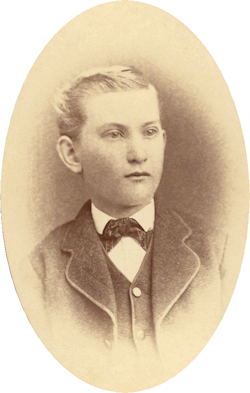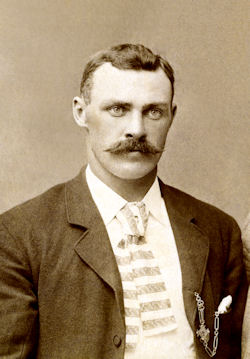 |
Herman V. Benitz | Page last modified: |
 |
Herman V. Benitz | Page last modified: |

Herman, age 10 years
ca.1873, Oakland, California
(Source: John C. Benitz)

Herman, age 27+/- years
ca.1890, Rosario, Santa Fé
(Source: F. Malcolm Benitz)
The youngest of William & Josephine’s children, he was born at Fort Ross (California, USA), 28 April, 1863. He was a child of 4 when the family moved to Oakland, and only 11 upon arrival in Argentina. Just 13 when his father died in 1876, he grew up at “La California.
Herman was reputed to have been a hard worker. According to the estancia day-books he helped his brothers run “La California”, “Laguna Yacaré”, and “Los Palmares”. He also appears in Alfred’s biography (in particular chapters XIV, XV, & XVI).
When his brothers were absent, Herman maintained the day-book of whichever estancia he was at. His entries are a challenge. Being the least educated amongst his siblings, his spelling and grammar were poor. Words he was unfamiliar with, whether in English or Spanish, he spelt phonetically as if pronounced in English. In addition, he may have suffered from dyslexia; for example, he typically spelt peón as poen. (Going by his brother John’s school records, Herman most likely completed third, possibly fourth, grade at the Lincoln School in Oakland before the family emigrated end of July, 1874. We have not seen mention of any further formal education.)
We have no letters or personal diaries written by Herman. Apart from these portraits he appears in only two other photos, taken of him and his crew installing a fence at “La California” in late 1892. They are not close-ups, but they do show he was a portly man of medium height.
His death was sudden and unexpected. He was only 29 years old. The following quotes are from the “La California” day-book of 1893:
Friday, January 13: “...Herman left for Mar del Plata for a months change. took 500.$ along [approx. $10,000 USD-2000]. went together with Mr Nash, in great spirits”
Wednesday, February 1: “Received a telegram from Mr Nash from Mar del Plata at 2. P.M. saying that Herman had died there last night at 9 P.M.
Johnie left for Alta Gracia to break the news to mother, and from there goes to Mar del Plata.”Friday, February 3: “Mother came back from Alta Gracia. she drove out from C. de Gomez in a hired carriage.”
Monday, February 6: “Johnie came back from Mar del Plata, he brought Hermans body back with him. Mr Spangler also came with him, and the body was buried in our cemetary.
William and R. Macintosh were present. also neighbors.”Sunday, February 12: “Alfred arrived from the Chaco.”
The following is from the website: British Settlers in Argentina and Uruguay:
Iglesia Evangélica Metodista, Argentina, Rosario
Funeral Record, Methodist Episcopal Church, Rosario 1865-1893
Registers A and B(Register B, Item 145, page 307)
Date of Burial — 6/2/1893
Date of Death — 31/1/1893
Name — Benitz, Hermann Vitalis
Place — Las Rosas
Age — 29
Notes — born at Fort Ross, California on 28/4/1863; died at Mar del Plata of gunshot wound and was brought from that place to his home on the Estancia California near Las Rosas; he was buried there
——————•◊•——————
Summarizing family lore regarding Herman’s death:
Herman’s body was found on the banks of an arroyo. He had been murdered, or had commited suicide, because of large gambling debts he was unable to pay, debts that caused the family financial stress.
Here are the issues with this tale: (1) It was Frank (Herman’s oldest brother) who, in 1881, caused the family great financial stress and who most likely drowned in a river; (2) if Herman left gambling debts, they were either small or uncollectable because two years later, in 1895, Benitz Hermanos were able to double their land holdings, buying estancia “Los Algarrobos”; (3) Mr. Nash’s telegram specified the hour of Herman’s death — how could Mr. Nash have known the time of death if the body had been found next to an arroyo? Unless, of course, he had been present when Herman was taken to a remote location and shot; (4) the “La California” day-book makes no mention of a violent death, however, then as now, suicide is often concealed.
Until we see an official account (death certificate, police report, etc.) of Herman’s death, we have no real facts to go by. It is unlikely we will ever know for local police departments are known to burn old records.
© Peter Benitz (Benitz Family)